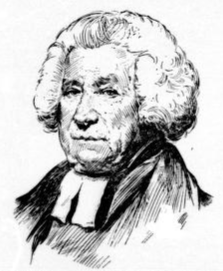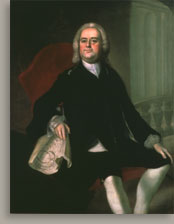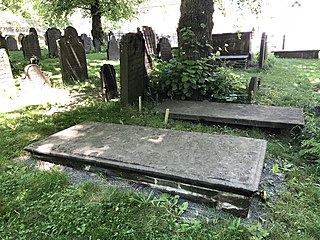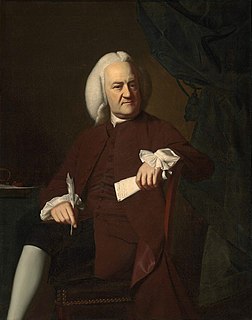
Sampson Salter Blowers was a noted North American lawyer, Loyalist and jurist from Nova Scotia who, along with Chief Justice Thomas Andrew Lumisden Strange, waged "judicial war" in his efforts to free Black Nova Scotian slaves from their owners, leading to the decline of slavery in Nova Scotia.

St. Paul's Church is an evangelical Anglican church in downtown Halifax, Nova Scotia, within the Diocese of Nova Scotia and Prince Edward Island of the Anglican Church of Canada. It is located at the south end of the Grand Parade, an open square in downtown Halifax with Halifax City Hall at the northern end.

The Old Burying Ground is a historic cemetery in Halifax, Nova Scotia, Canada. It is located at the intersection of Barrington Street and Spring Garden Road in Downtown Halifax.
Edward Winslow was a loyalist officer and New Brunswick judge and official.

Rev Dr John Breynton was a renowned minister in Halifax, Nova Scotia, Canada.

Jonathan Binney was a merchant, judge and political figure in Nova Scotia. He was a member of the 1st Nova Scotia House of Assembly from 1758 to 1764. He arrived in Nova Scotia in 1753. His father-in-law was Henry Newton (politician). Binney was buried, along with his two sons Stephen and Hibbert, in the Old Burying Ground.

Benjamin Green was a merchant, judge and political figure in Nova Scotia. He served as administrator for Nova Scotia in 1766 and from 1771 to 1772. He was born in Salem Village, the son of the Reverend Joseph Green and Elizabeth Gerrish, and entered business with his brothers in Boston. In 1737, he married Margaret Pierce. He was secretary to William Pepperrell, who led the attack against Louisbourg in 1745, and served as treasurer for the forces from New England and secretary for the council that administered Louisbourg after its capture. In 1749, he went to Halifax, where he was named to Edward Cornwallis's Nova Scotia Council and also served as naval officer. Green was also judge in the vice admiralty court; he resigned in 1753. In 1750, he became secretary to the Council and provincial treasurer. Green was named a justice of the peace in 1760. While in England to assist in auditing the accounts of Peregrine Thomas Hopson, he had to defend himself against charges of assigning contracts to Malachy Salter in exchange for a share in the profits. He was reprimanded but allowed to retain his posts. During his term as administrator in 1766, he was criticized by the provincial assembly for not following the correct procedures for dealing with the provincial finances. Green resigned his post as provincial treasurer in 1768, citing poor health.
Joseph Fairbanks was a merchant and political figure in Nova Scotia. He was a member of the 1st General Assembly of Nova Scotia and represented Halifax township in the Nova Scotia House of Assembly from 1776 to 1785.
Jonathan Sterns was a Loyalist from Boston, Solicitor General for Nova Scotia and political figure in Nova Scotia. He represented Halifax County in the Nova Scotia House of Assembly from 1793 to 1798.

Admiral Sir Rupert George was British naval officer in the American Revolution, became the Commodore for the Royal Navy's North America Station (1792-1794). He then returned to England and became the first Commissioner of the Transport Service, where he stayed for 22 years.

Thomas Gilbert (1715-1797) was a soldier in King George's War, the French and Indian War and the American Revolution. He was known as the "Leader of the New England Tories." He became a Loyalist, originally from Assonet in Freetown, Massachusetts, he settled a community that was eventually named after him, Gilberts Cove, Nova Scotia.

Benjamin Kent (1708–1788) was the first Patriot to become Massachusetts Attorney General (1776-1777) and then acting Attorney General during much of Robert Treat Paine's tenure (1777-1785).. He was appointed seven successive terms. Prior to the American Revolution, Kent was notable for his representation of slaves suing their masters for their freedom, which contributed to the demise of slavery in Massachusetts. He was a member of the North End Caucus and prominent member of the Sons of Liberty, which formed to protest the passage of the Stamp Act of 1765. The efforts of the Sons of Liberty created the foundation for the Boston Tea Party. Kent called for independence early in the American Revolution.

Foster Hutchinson Jr. was a member of the Nova Scotia Council and one of the Puisne judges of the Supreme Court of Nova Scotia. He was the only son of Foster Hutchinson (judge), Sr., the nephew of Governor of Massachusetts Thomas Hutchinson and grandchild of Governor of Nova Scotia Paul Mascarene. He arrived in Halifax from Boston with his father as Loyalists (1776). Hutchinson became a lawyer and worked under Chief Justice Thomas Andrew Lumisden Strange. Sir George Prévost appointed him an Assistant Justice to the Supreme Court (1809). He is buried in the Old Burying Ground.

Edward Winslow was a loyalist who was a government official in Boston until he moved to Halifax, Nova Scotia in 1776 during the American Revolution. He was the great grandson of Mayflower Pilgrim Edward Winslow. During Father Rale's War, Winslows older brother Josiah was given the command of Fort St. George and was killed by natives of the Wabanaki Confederacy in the Northeast Coast Campaign (1724). He was also the father of loyalist Edward Winslow.

Hibbert Newton Binney (1766–1842) was a soldier in the Royal Nova Scotia Volunteer Regiment in the American Revolution. He became a member of the Nova Scotia Council. He was also a painter who created some of the earliest images of the Mi'kmaq people. He was the grandson of Henry Newton and the son of Jonathan Binney who was a signatory to one of the Halifax Treaties with the Mi'kmaq. Hibbert is buried in the Old Burying Ground. There is a mural tablet at St. Paul's Church (Halifax) to his son commander Lieut. John Binney and 11 crew of the mail packet brig Star, that all died at sea. Hibbert was the His grandfathers were Henry Newton (politician) and Bishop Hibbert Binney. He was also the son-in-law of John Creighton (judge).

Thomas Shreve was a Loyalist during the American Revolution and later served as the first rector of St. George's Anglican Church (1787) and then became a prominent minister of St. John's Anglican Church (Lunenburg), Nova Scotia.
The Raid on Annapolis Royal took place on 29 August 1781 during the American Revolutionary War. The raid involved two American privateers - the Resolution and the Reprisal - attacking and pillaging Annapolis Royal, Nova Scotia to revenge the British destruction of the Penobscot Expedition. One historian described it as "one of the most daring and dramatic raids upon Nova Scotia."

Nova Scotia was heavily involved in the American Revolution. The American Revolution (1776–1783) had a significant impact on shaping Nova Scotia. At the beginning, there was ambivalence in Nova Scotia, "the 14th American Colony" as some called it, over whether the colony should join the Americans in the war against Britain. Largely as a result of American Privateer attacks on Nova Scotia villages, as the war continued, the population of Nova Scotia solidified their support for the British. Nova Scotians were also influenced to remain loyal to Britain by the presence of British military units, judicial prosecution by the Nova Scotia Governors and the efforts of Reverend Henry Alline.

Ezekiel Goldthwait (1710-1782) was a wealthy businessman and landowner in colonial Boston, Massachusetts. He was one of the foremost citizens and prominent in the town's affairs in the years leading up to the American Revolution.

Captain John Selman (1744-1817) was a privateer who served in the Marblehead Regiment and commanded the USS Franklin for George Washington’s first expedition of the American Navy, which was ordered to interrupt the shipping of British armaments off Nova Scotia. Broughton also participated in the Raid on Charlottetown (1775).

















